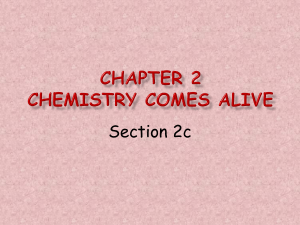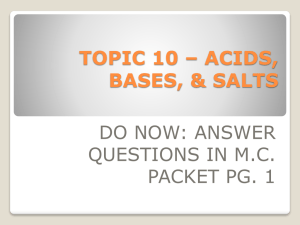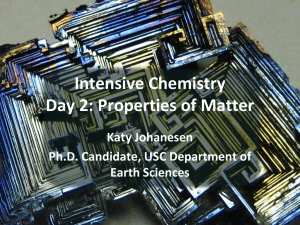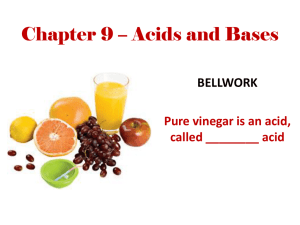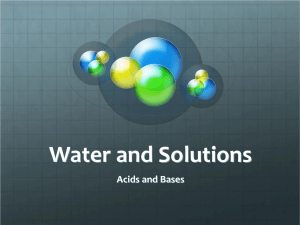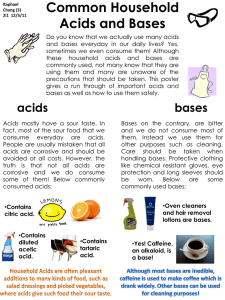Chapter 2 - Part 3
advertisement
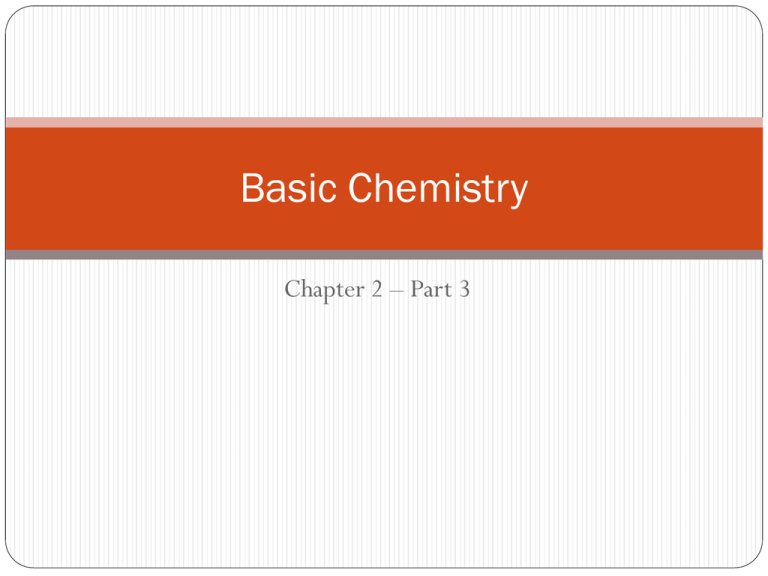
Basic Chemistry Chapter 2 – Part 3 Organic vs. Inorganic Compounds Organic Compounds – Carbon-containing compounds. Include: Carbohydrates, lipids, proteins, and nucleic acids. All are fairly or very large covalently bonded molecules. Inorganic Compounds – Do not contain carbon. Tend to be simpler, smaller molecules. Include: Water, salts, and many (but not all) acids and bases. Exception: Carbon dioxide (contains carbon but is classified as inorganic) Water Most abundant inorganic compound in the body (accounts for 2/3 of body weight). There are four properties of water that make water so vital: 1. High Heat Capacity 2. Polarity/Solvent Properties 3. Chemical Reactivity 4. Cushioning High Heat Capacity It absorbs and releases large amounts of heat before its temperature changes appreciably. Prevents sudden changes in body temperature. The hydrogen bond is what gives water its heat capacity. Polarity/Solvent Properties - Because of its polarity, water is an excellent solvent. Molecules cannot react chemically unless they are in solution, so virtually all chemical reactions in the body depend upon water’s solvent properties. Because nutrients, respiratory gases, and wastes can dissolve in water, water can act as a transport and exchange medium in the body. + Polarity/Solvent Properties (continued) Specialized molecules that lubricate the body also use water as their solvent. Examples: Mucous that eases feces along the large intestines Saliva which moistens food and prepares it for digestion Serous fluids which reduce friction between internal organs Synovial fluids which “oil” the ends of bones as they move within joint cavities. Chemical Reactivity Water is an important reactant in some types of chemical reactions. Example: To digest foods, water molecules are added to the bonds of the larger molecules. Such reactions are called hydrolysis reactions. Condensation reactions occur in the synthesis of biological molecules, including proteins, carbohydrates, fats, and nucleic acids. These reactions join smaller molecules into larger molecules. Cushioning Water also serves a protective function. Examples: Cerebrospinal fluid forms a cushion around the brain that helps to protect it from physical trauma. Amniotic fluid protects a developing fetus in the mother’s womb. Salts The salts of many metal compounds are commonly found in the body. Most plentiful salts are calcium and phosphorus (found mainly in the teeth and bones). When dissolved in body fluids, salts easily separate into their ions Called dissociation and occurs rather easily by the polar water molecules Salts Salts, both in their ionic forms and in combination with other elements, are vital to body functioning. Examples: Sodium and potassium ions are essential for nerve impulse. Iron forms part of the hemoglobin molecule that transports oxygen within red blood cells. Salts and Electrolytes Because ions are charged particles, all salts are electrolytes – substances that conduct an electrical current in solution. When ionic or electrolyte imbalance is severely disturbed, virtually nothing in the body works. Acids and Bases Like salts, acids and bases are electrolytes. They ionize and then dissociate in water and can then conduct an electrical current. Characteristics of Acids Sour taste Can dissolve many metals or “burn” a hole in your rug. Substance that can release hydrogen ions (H+) in detectable amounts. When acids are dissolved in water, they release hydrogen ions and some ions. Also defined as a proton donor. Strong Acids Strong Acids – Acids that ionize completely and liberate all of their protons. Examples include: Hydrochloric acid produced by stomach cells that aid in digestion. HCl → H+ + Cl(Hydrochloric Acid) (proton) (anion) Weak Acids Weak Acids – Acids that ionize incompletely. Examples: Carbonic acid and acetic acid H2CO3 → H+ + HCO3- + H2CO3 (Carbonic Acid) (proton) (anion) (Carbonic Acid) Characteristics of Bases Bitter Taste Feel Slippery Proton Acceptors Releases the hydroxyl ion (OH-) and some cations. NaOH → Na+ + OH(Sodium Hydroxide) (cation) (hydroxyl ion) Strong vs. Weak Bases Strong Base – Any base containing OH NaOH is a strong base because it’s an avid proton (H+) seeker. Weak Base – A base that does not contain OH Bicarbonate ion (HCO3-) is an important base in the blood and is a fairly weak base. Neutralization Reactions When acids and bases are mixed, they react with each other (in an exchange reaction) to form water and a salt. Called a Neutralization Reaction. HCl + NaOH → H2O + NaCl (acid) (base) (water) (salt) pH: Acid Base Concentrations The relative concentration of hydrogen and hydroxyl ions in various body fluids is measured in concentration units called pH units. pH scale: 1-14 10 11 12 13 14 More Acidic H+ 1 2 3 4 5 6 7 8 9 Neutral More Basic OH- 0 • Litmus paper is used as an indicator for acids and bases. Acidic turns blue litmus to red Basic turns red litmus to blue If there are more H+ than OH-, then the chemical is an acid. H+ H O OHIf there are Less H+ than OH-, then the chemical is a base. H+ H O OHIf there are equal amounts of H+ and OH-, then the chemical is neutral. + H H O OH- . Buffers Living cells are extraordinary sensitive to even slight changes in pH. Acid-base balance is carefully regulated by the kidneys, lungs, and a number of chemicals called buffers, which are present in body fluids. Weak acids and weak bases are important components of the body’s buffer systems. Blood pH Because blood comes into close contact with nearly every body cell, regulation of blood pH is especially critical. Blood pH has a narrow range of 7.35 - 7.45. When blood pH changes more than a few tenths of a pH unit from these limits, death is possible. Example: When blood pH dips into the acid range, the amount of life-sustaining oxygen that the hemoglobin in blood can carry to body cells begins to decline rapidly to dangerously low levels.
